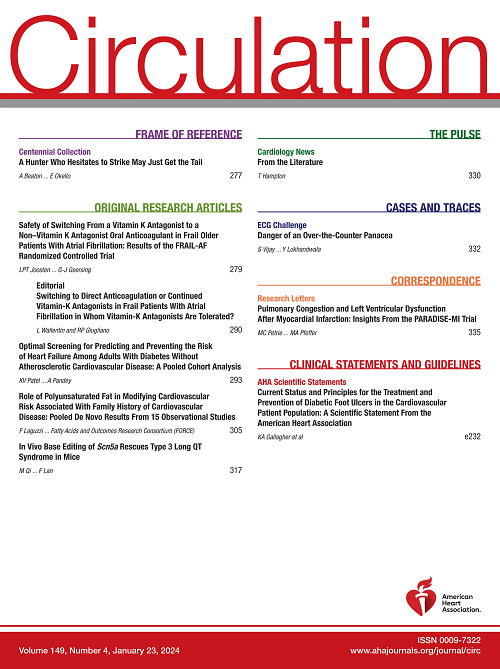Muscle Mass and Glucagon-Like Peptide-1 Receptor Agonists: Adaptive or Maladaptive Response to Weight Loss?
IF 38.6
1区 医学
Q1 CARDIAC & CARDIOVASCULAR SYSTEMS
引用次数: 0
Abstract
Recent studies have shown that pharmacologic weight loss with glucagon-like peptide-1 receptor agonists (GLP-1 RAs) and combination therapies is approaching magnitudes achieved with surgery. However, as more weight loss is achieved, there is concern for potential adverse effects on muscle quantity, composition, and function. This primer aims to address whether muscle-related changes associated with weight loss treatments such as GLP-1 RAs may be maladaptive (ie, adversely affecting muscle health or function), adaptive (ie, a physiologic response to weight loss maintaining or minimally affecting muscle health or function), or perhaps an enhanced response to weight loss (ie, improved muscle health or function after treatment). Based on contemporary evidence with the addition of studies using magnetic resonance imaging, skeletal muscle changes with GLP-1 RA treatments appear to be adaptive: changes in muscle volume z-score indicate a change in muscle volume that is commensurate with what is expected given aging, disease status, and weight loss achieved, and the improvement in insulin sensitivity and muscle fat infiltration likely contributes to an adaptive process with improved muscle quality, lowering the probability for loss in strength and function. Nevertheless, factors such as older age and prefrailty may influence the selection of appropriate candidates for these therapies because of risk for sarcopenia. Several pharmacologic treatments to maintain or improve muscle mass designed in combination with GLP-1-based therapies are under development. For future development of GLP-1-based therapies (and other therapies) designed for weight loss, as well as for patient-centered treatment optimization, the introduction of more objective and comprehensive ways of assessing muscle health (including accurate and meaningful assessments of muscle quantity, composition, function, mobility, and strength) is important for the substantial numbers of patients who will likely be taking these medications well into the future.肌肉质量与胰高血糖素样肽-1 受体激动剂:减肥的适应性反应还是适应性不良反应?
最近的研究表明,使用胰高血糖素样肽-1 受体激动剂(GLP-1 RAs)和联合疗法的药物减肥效果已接近手术减肥的效果。然而,随着体重的减轻,人们开始关注对肌肉数量、组成和功能的潜在不利影响。本入门指南旨在探讨与 GLP-1 RAs 等减肥疗法相关的肌肉相关变化是否可能是适应性不良(即对肌肉健康或功能产生不利影响)、适应性不良(即对减肥的生理反应,维持或最小化对肌肉健康或功能的影响),或者可能是对减肥的增强反应(即治疗后肌肉健康或功能得到改善)。根据使用磁共振成像研究的最新证据,GLP-1 RA 治疗后骨骼肌的变化似乎是适应性的:肌肉体积 Z 值的变化表明,肌肉体积的变化与预期的老化、疾病状态和体重减轻情况相符,胰岛素敏感性和肌肉脂肪浸润的改善可能有助于改善肌肉质量的适应过程,降低力量和功能丧失的可能性。不过,由于存在肌肉疏松症的风险,年龄较大和体质较弱等因素可能会影响这些疗法合适人选的选择。目前正在开发几种与 GLP-1 疗法相结合的药物疗法,以维持或改善肌肉质量。对于未来开发用于减肥的 GLP-1 疗法(和其他疗法)以及以患者为中心的治疗优化而言,采用更客观、更全面的方法来评估肌肉健康状况(包括对肌肉数量、组成、功能、活动度和力量进行准确而有意义的评估),对于未来可能会服用这些药物的大量患者而言非常重要。
本文章由计算机程序翻译,如有差异,请以英文原文为准。
求助全文
约1分钟内获得全文
求助全文
来源期刊

Circulation
医学-外周血管病
CiteScore
45.70
自引率
2.10%
发文量
1473
审稿时长
2 months
期刊介绍:
Circulation is a platform that publishes a diverse range of content related to cardiovascular health and disease. This includes original research manuscripts, review articles, and other contributions spanning observational studies, clinical trials, epidemiology, health services, outcomes studies, and advancements in basic and translational research. The journal serves as a vital resource for professionals and researchers in the field of cardiovascular health, providing a comprehensive platform for disseminating knowledge and fostering advancements in the understanding and management of cardiovascular issues.
 求助内容:
求助内容: 应助结果提醒方式:
应助结果提醒方式:


